
Nadzab airfield, New Guinea. 1943.
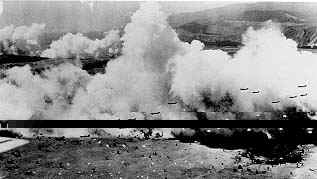
 www.youtube.com/watch?v=wuz0TpzqwWY
www.youtube.com/watch?v=wuz0TpzqwWY
Airlift historian and USAF C-130 Vietnam combat veteran, Sam McGowan writes:
"...the Airborne assault on Nadzab, an airstrip in the Markham Valley in Papau New Guinea in the fall of 1943. If there is a single World War II battle that deserves to be studied by modern advocates of Airborne and Airland operations, Nadzab is it.
The attack on Nadzab was planned and executed by the air staff of the Fifth Air Force, the air element of the Southwestern Pacific Command of General Douglas MacArthur. Lt. Gen. George C. Kenney, the Fifth Air Force commander, conceived the attack as a means of catching the Japanese forces at Lae in a pinch between Airborne and Airlifted troops attacking from the northwest and infantry attacking up along the Huon Peninsula (sometimes called the Lae Peninsula) from the southeast. Nadzab was the fruition of a plan Kenney conceived in early 1943 after American and Australian troops, many of whom had been airlifted across the Owen Stanley Mountains, defeated the Japanese force at Buna, a village southeast of Lae. Kenney conceived an Airborne attack at a time when he had no Airborne forces at his disposal. During a visit to the United States in the spring of 1943 Kenney requested the assignment of an Airborne Division to his command. Instead of a Division he got a Regiment, the 503rd Parachute Infantry (the 11th Airborne Division arrived in the Pacific in time for the invasion of the Philippines.)
During the interim prior to the arrival of the first American Paratroops in the Southwest Pacific, Kenney ordered the construction of a secret advanced airfield on the north slopes of the Owen Stanleys less than a hundred miles south of Lae. The new field, at a village known as Tsili-Tsili (and pronounced
Silly-Silly) was constructed entirely by airlift. Engineers and construction materials were flown into an existing strip at Marlinan, about four miles from the new site. (The Marlinan strip was not suitable for use by fighters, but it was suitable for C-47s.) Originally the engineers planned to use jeeps and trailers to transport materials between the two bases, until someone came up with the idea of sawing Army trucks in half and transporting the halves in C-47s, then reassembling them in the field. It was not until the base was ready for fighters that it was detected by the Japanese. An attack caught a formation of C-47s as they were approaching to land. At least one transport was shot-down before U.S. fighters broke up the attack.
The Nadzab attack was planned as a two-fold operation. American Paratroops airlifted from Port Moresby would jump onto an existing, but lightly defended, airstrip and secure the field while the C-47s returned to Marlinan to pick up/airland Australian infantry who had been prepositioned there by airlift in
anticipation of the operation.
On the morning of the attack the drop formation of some 90 C-47s from the 374th, 317th and 375th Troop Carrier Groups took off from Seven Mile Aerodrome at Port Moresby and assembled over the field. While the C-47s were assembling into drop formation, then heading out for the drop zone at Nadzab three groups of powerfully armed B-25 strafers were taking off from other airfields in the area. Though factory produced versions of the B-25 gunships would later serve in the Pacific, the airplanes at Nadzab were mostly conventional B-25 medium bombers that had been converted in the field into forward-firing gunships. The bombardier's position was removed from the airplane and the nose was filled with a battery of eight .50-caliber machineguns while additional guns were installed in pods mounted on the sides and bottom of the bombers, giving each B-25 a battery of 12-14 x .50-caliber [heavy] machineguns firing forward along the longitudional axis of the airplane.
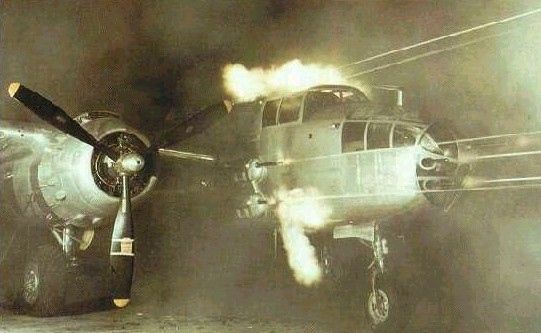
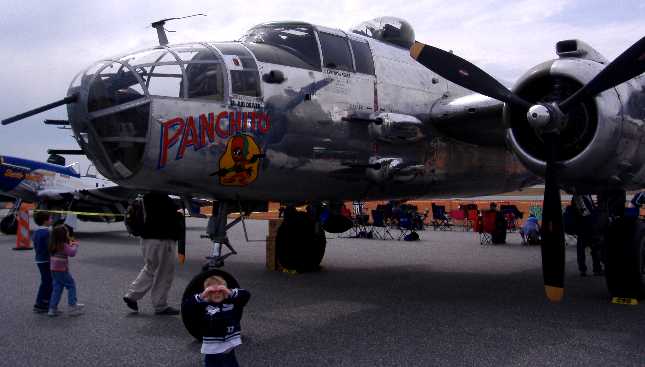
In addition to the machineguns, each B-25 carried a bomb-bay full of small parachute-fragmentation bombs, bombs that floated to earth beneath parachutes to detonate right above the ground, spraying fragments in every direction.
Minutes before the C-47s arrived over the Nadzab drop zone, a very large force (as many as 90 ships) of B-25 gunships hit the airfield. After strafing the drop zone, the B-25s dropped their loads of parafrag bombs. As the last B-25 left the field a flight of A-20s came over and dispensed a cloud of smoke around the DZ to conceal the troopers from the enemy postions in the trees. Above the airstrip a flight of three VIP-carrying B-17s observed the operation. General Kenney was in one airplane, General Douglas MacArthur (who was erroneously referred to by some of his men as "Dougout Dug") was in another. A fighter cover of P-38s and P-39s kept the Japanese fighters at bay.
The Paratroopers landed under the concealment of the smoke without taking a single casualty from enemy fire. Within minutes after they were on the ground, the Japanese on the airfield surrendered with very little resistance. The Paratroops hurriedly secured the airfield perimeter and prepared the airstrip for the arrival of troop carrying C-47s that began arriving in the afternoon. As the C-47s arrived, the Australian infantry assembled and, along with the American Paratroops, began attacking toward Lae.
Now that, folks, is how an Airborne operation is supposed to work, as conceived by General Billy Mitchell and further developed in the minds of men like Kenney, who had served as an observer in Europe in 1940. The Airborne attack was swift and sure, and it followed behind a massive aerial attack by heavily armed, fixed-wing gunships who literally swept the area with heavy machinegun fire. The Allies had previously achieved aerial superiority, the gunships suppressed the fire of the Japanese troops who were in the vicinity of the previously determined-to-be lightly defended area and the troops jumped onto a DZ where they met little resistance.
I might also add that the operation was planned and executed, not by a massive staff in Washington, at Fort Bragg and at Scott or Eglin, but by a commander and staff in the field who knew the area and the military situation, and who tailored their operation for the conditions. In fact, the whole thing was carried out by a single command that included heavy bombers, medium bombers, fighters and transports as well as Airborne forces and infantry. And it worked. Its like the 'new concept' Oregon Jerry Baird reported from the Wall Street Journal, Monday Aug 3; 'Air Force to Reorganize into 10 Units, Marking Post-Cold War Strategy Shift':
The Air Force plans tomorrow to unveil a major reorganization into 10 'expeditionary' units. The restructuring into the free-standing units each capable of quick-deployment appears to be the biggest shift any branch of the armed services has made in an effort to adjust to the post-cold war world.AF personnel have complained about grag-bag deployments in which units are sent abroad on short notice, with some having served five rotations in Kuwait and Saudi Arabia over the past seven years.
Each of the 10 units will contain roughly 250 aircraft: 18 x F-15C air-to-air-fighters; 10 x F-15E ground-attack jets; eight x F-16s dedicated to attacking enemy antiaircraft installations; 12 x A-10s for supporting ground forces especially for attacking tanks; plus a host of support aircraft for refueling, transport and surveillance.
About 75 of the aircraft of each unit will fly overseas, while the rest of each unit most notably the crown jewels of the air fleet, such as stealthy F-117 and B-2 Bombers, U-2 reconnaisance planes, and major command-and-control aircraft-- will remain in the U.S. 'on call' for immediate movement overseas, Gen Wald said.
We previously called them Numbered Air Forces."
Thus, the U.S. Army Paratroopers of the 1/503rd PIR roar over the smoke in C-47s and jump in at an incredibly low 250 feet! The airfield is taken over quickly with light casualties as the Kenney/MacArthur, Air/Ground team began their amazing run of spectacular victories against the Japanese without the thousands of friendly casualties the frontalist approach used by the Navy/mc in the North Pacific received.
Arm Troop Carrying Aircraft With Air-to-Air Missiles (AAMs)
One of the reasons why U.S. Army Lieutenant General James Gavin created the night parachute jump was because he lacked fighter aircraft to escort his transports carrying his paratroops to ward off enemy fighters. A parasite fighter concept that the transports themselves carry to insure air cover is something to consider if air refueling tankers are not available to keep fighters aloft to accompany paratroop transports.
Sadly, fighters cannot be everywhere and enemy MIGs have been in the past able to kill our men while in troop transports. Here's a horror story from Vietnam:
North Vietnam. 28 January 1970.
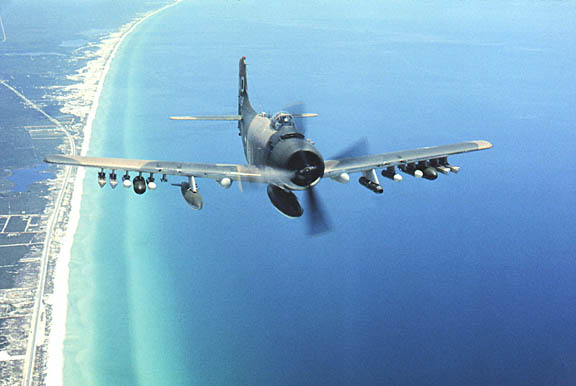
Jim "Jink" Bender (Sandy 04):
"I was one of the Sandy wingmen, Sandy 04. It was a bad day all around. The SAR was for SeaBird 02 and the shootdown location was in North Vietnam. While Sandy 01 was ascertaining the exact location and condition of survivors he had a SAM fired at him. SA-2 as I recall. I think Capt. John Dyer was Sandy 05. Sandy's 5 & 6 were escorting a formation of 4 Jolly's (70, 71, 72 ,& 77). They had arrived from the West Northwest at about 10,000 ft. Jolly 19 (I think) was the primary low helicopter and he decided to refuel early. A C-130, King 03, and the Jolly 19 headed a ways west at about 7,000 ft to conduct the refueling and I went along to provide cover. We were all holding west along the border in Laos, waiting to see how things were going to transpire.
We were receiving several MIG calls but none of us were familiar with the reference point, CRAB, used by the radar guys. After listening to the tape someone reports that the Mig position is some 15 Miles north of us. Anyway, shortly thereafter, people started yelling "Migs!" and Jolly 71 disappeared in smoke. King 03 dropped his tanks and headed west into the weeds and the now disconnected refueling Jolly 19 did the same. Apparently two Migs made one pass through the holding helicopter formation and escaped to the North. Jolly 72 was in loose trail with Jolly 71 when the missile and Mig passed them on the right and hit Jolly 71.
Well, it was chaos after that!! Everyone in the SAR force was headed west at this time to RTB. My notes say that Sandy 01 was unable to contact any SeaBird 02 survivor. My tape is from the cockpit of Jolly 72 whose Aircraft Commander was reported to be LTC Shipman. My notes also show the AC of King 03 was Lt. Casey Quinn, USCG. I can't remember who was piloting Sandy 01, 02, 03, or 06.
Seabird 02. The F-105 crew, although having ejected safely, never made it into the POW system....
The events described here took place in North Vietnam north of Mu Gia pass. Seabird 02 was down in the foothills along the route structure leading north out of Mu Gia. Jolly Green 71 was northwest of this area in the high terrain along the border of Laos and North Vietnam.
An interesting note is that the two sets of coordinates given for the crash site of JG 71 do not agree. The Lat-Longs given are N 180200 E 1053300 which puts the crash site inside Laos. The UTM coordinates of WF 582048 move the crash site north, into North Vietnam."
From Jolly Green 71 Downed by MiG-21 on the Skyraider Association homepage
As much as we like to count on Air Supremacy, there is no guarantee that a "leaker" might get through our F-15 Eagle and/or F-22 Raptor "top cover" and today's "Sandy" or "Spad", the venerable A-10 "Warthog" and still get a shot at a troop carrying aircraft. Like the C-46 Commandos that were hit during the Rhine River crossing, its likely Paratroopers hooked-up to jump will exit the aircraft before going down. However we just lost an aircraft for no reason.
There is of course the ever present threat from man-portable air defense systems (MANPADS) and small arms fire on the ground which need to be cleared before the formation comes in to drop Paratroopers. While SAMs are deadly, they are hardly the only threat that must be faced by aircraft operating in close proximity to an enemy force, particularly those operating at altitudes below 2,000 feet.
Ever since World War II combat aircrew members have known that the PRIMARY threat to aircraft operating at low altitudes is small-arms fire. This was true in World War II, it was true in Korea, it was true in Vietnam, Desert Storm I and II, today in Iraq--and it will be true in the next war. While shoulder-fired SAMs (MANPADS) allow small units to have a more effective weapon against low-flying aircraft, this does not mean they are the only threat. In Vietnam, a crew-served automatic weapon of .50 or .51-caliber (Dshka 12.7mm) HMG was considered to be "heavy" antiaircraft by U.S. Army helicopters and other fixed-wing aircraft operating exclusively in South Vietnam. In the out-of-country, nation-state war against North Vietnam, such weapons were considered "small potatoes", but this was because jet strike aircraft typically did not go below 2,000 feet, which is the effective altitude of small-arms fire up to and including .50 caliber HMGs. Larger caliber weapons such as 23mm and 37mm are effective up to about 10,000 feet, while larger calibers can reach up into the crusing flight Levels.
Airlift aircraft, whether C-130s, C-17s, C-141s, C-5s or helicopters must, by necessity, operate at very low altitudes during LVAD CDS and current static-line mass tactical (airdrop) Airborne and Airland operations. As such, they are exposed to an environment in which every type of weapon can be a threat. For example, during the evacuation of Kham Duc on May 12, 1968 in the Vietnam War the attacking NVA forces were not equipped with antiaircraft as such, other than a few crew-served weapons. Yet they managed to shoot down no less than ten airplanes and helicopters, including two C-130s. One C-130 was brought down by the combined fire of a pair of .50-caliber heavy machineguns which may have been captured from the Americans earlier in the day while the other was brought down by AK-47 fire. Consider this - a company of enemy troops equipped with AKMs ("AK-47s") is capable of putting a lot of bullets into the air, as many as 4,000 rounds if each is equipped with a 30-round magazine. An unarmored airlift airplane struck by even a quarter of those rounds is going to be in very big trouble.
Another factor that must be considered is that a large infantry force supported by crew-served weapons is capable of putting up a literal wall of fire, as happened during the seige of An Loc in the spring of 1972. Bear in mind that the American C-130 and Vietnamese C-123 crews charged with resupplying the garrison at An Loc was completely INEFFECTIVE until the development of accurate high altitude drop methods that allowed deliveries from above the effective range of the antiaircraft and small arms fire that was present on the ground. Three USAF C-130Es and (at least) two VNAF C-123s were shot down at An Loc during the low-level drops in which the tonnage actually retrieved by those on the ground was minuscle. In short, the battle of An Loc ushered in a new dimension in airlift, yet very little attention seems to be paid to this fact by those responsible for modern airlift planning.
What am I saying? Well, for one thing "250 knots at 250 feet" is not always an effective defense against ground fire. Only Russian-style drogue-chute parachutes can be jumped by Paratroopers at such high speeds. While a single airplane will probably be overhead and gone in such a situation, any others that follow will be susceptible to ground fire, regardless of whether the mission is flown at night or in the daytime. At the same time, if the defenders have any indication that the low-flying aircraft are on their way - and they likely will - barrage tactics with automatic weapons can cause tremendous harm to an Airdrop or Airland formation, whether large or small.
New AC-17 Gunship?
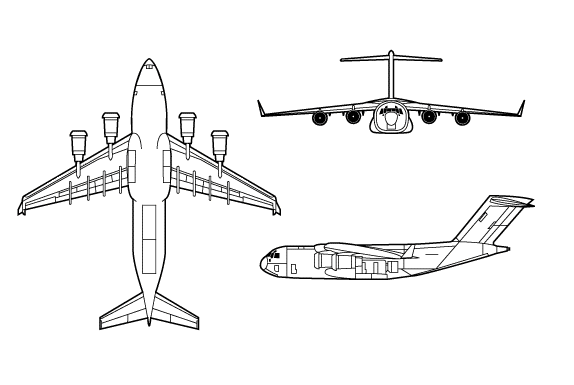
 www.youtube.com/view_play_list?p=676B2204D9780692
www.youtube.com/view_play_list?p=676B2204D9780692
The inevitable conclusion to this is that we need a new gunship aircraft that can accompany the Paratroop-carrying 400-mph C-130J Hercules and faster 500 mph C-17 Globemaster IIIs from beginning to end of mission---a gunship version of the C-17 that can fly at the same speeds/altitudes as the C-17, and another for Army helicopters. Another possibility would be a modified C-141B Starlifter or the new C-27J "Mini-Herk" or Army rotorcraft as Super theorist Sam McGowan envisions a smaller B-26 Invader-type aircraft with multiple rows of machines guns and directed-energy laser weapons like used on Bradley Fighting Vehicles equipped with the "Stingray" system to defeat MANPADS optics.
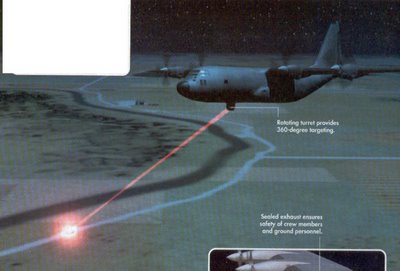
These aircraft would be at the front and tail end of the Airborne/Air Assault formation serial. This is how they would be equipped:
Air-to-Air threat
Each would have winglets above the landing gear fuselage bulges wing weapons stations. These would have AMRAAM radar guided missiles to destroy any marauding enemy aircraft detected ahead by the lead AC-17 Spectre III and to the rear of the trailing AC-17 Spectre III, which wuld have its AMRAAM missiles facing rearward. The AMRAAM fired by a F-16 Fighting Falcon has killed a once thought-invincible Mach 3.2 MIG-25 Foxbat of the Iraqi AF violating the no-fly zone in 1992.
Additionally there would be Stinger AAMs or Sidewinder AAMs to cope with any closer-in threats by slower-moving enemy ground vehicles or helicopters, as well as beaucoup decoys flares and chaff. 2.75" Hydra-70mm rockets with APERS flechettes would round out the straight-ahead threats the AC-17 might have to suppress/kill.
Ground threats
Since the Airdrop formation has to fly straight and level briefly, the AC-17 would an Electro-Optimal Counter Measure (EOCM) system looking out for ALL optic reflections, that once detected could be neutralized by narrowing the laser beam to burn out the optic and temporarily blind its user. EOCM on an Airborne gunship is a revolutionary weapon capable of clearing the air corridors for aircraft to pass and deliver their Army Paratroopers.
The AC-17 would have two banks of 4X 20mm Gatling cannon on both sides of the fuselage to rake both sides of the DZ as it flies ahead, aimed by forward-looking infared (FLIR). The "Sunday punch" would be a 105mm howitzer on the left side that could be further utilized after the AC-17 is free to seek targets of opportunity. The 167,000 pound payload of the AC-17 leaves a lot of potential for ammunition and weapons loads to saturate the DZ prior to a drop. 40mm Bofors cannon would allow higher altitude massed fires in conjuction with the 105mm cannon. The AC-17 would be able to lay down a large smoke screen with its four turbofan engines to mask the incoming Paratrooper force from visually aimed small-arms fire, just like General Kenney's A-20s did at Nadzab.
The second threat to an AIRBORNE forced entry is threat indirect fire weapons, illustrated best by the Vietminh closing down the airfield at Dien Bien Phu in 1954. The AC-17 would have a side-looking radar in its tail to direction find enemy artillery and mortar shells for counter-battery fire from the Airborne's tube and HIMARS rocket artillery and EFOGMs or its own airborne weapons. The AC-17 should have a weapons station to control and "fly" EFOGMs to strike at precision targets acquired from its SLAR and FLIR.
BLU82 15,000 pound bombs can create Drop/Landing Zones instantly(photo from BLU-82 combat vet Sam McGowan)
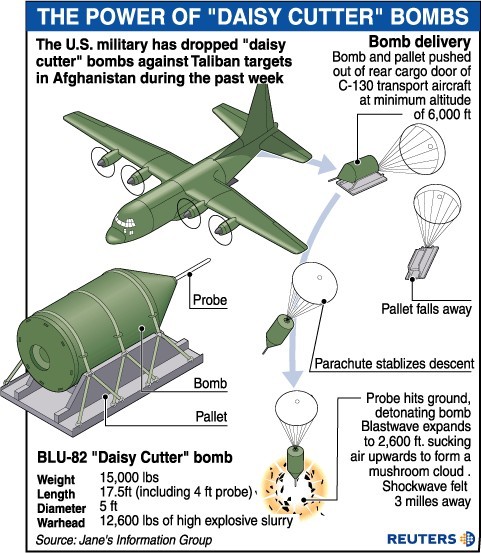
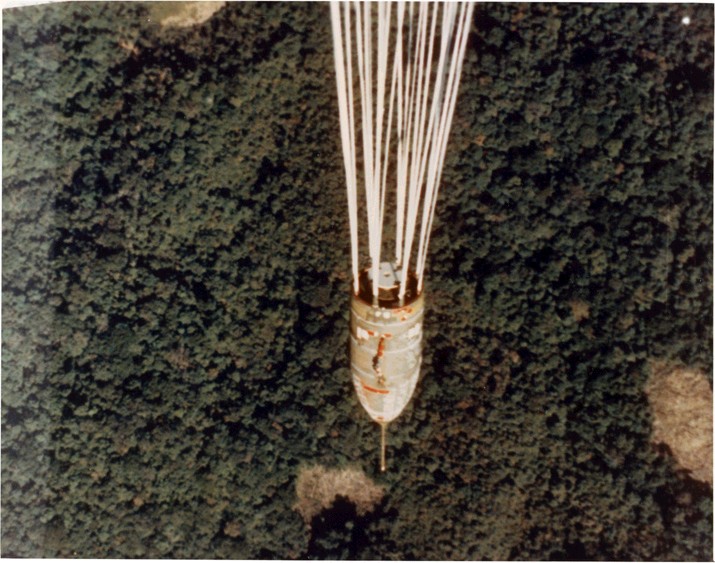
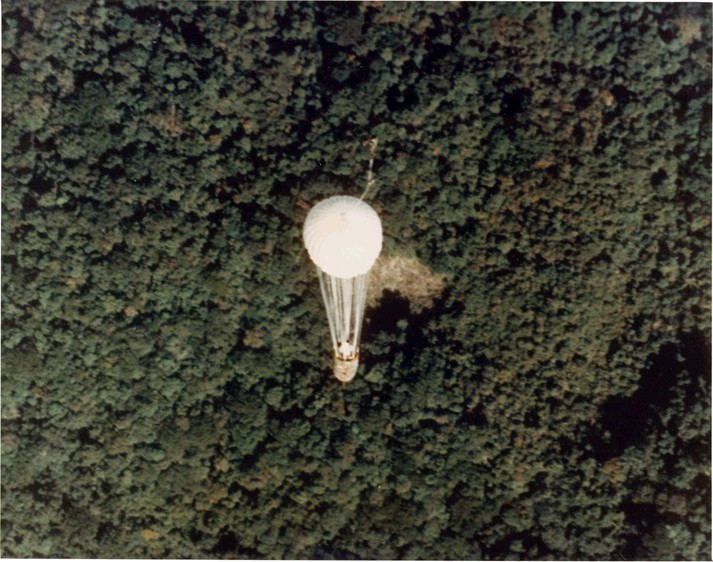
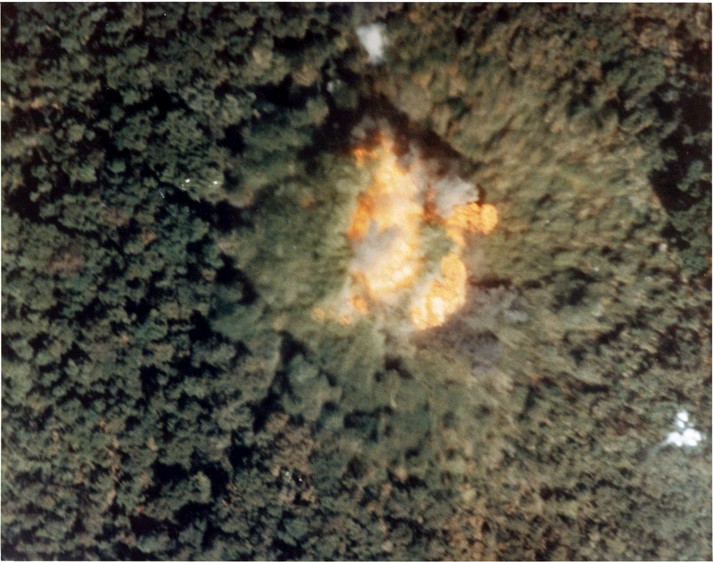
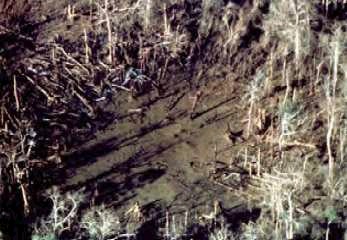
The final weapon as the AC-17 pulls away from the intended DZ would roll out its rear ramp: a drogue parachute fuel-air explosive (FAE) bomb which with its almost miniature nuclear blast effect kill every enemy Soldier within several miles of impact. With trial and error we may be able to come up with a string of smaller FAE bombs that can kill enemy Soldiers but not crater a desired runway or stretch of road/highway we seek to use an Assault Zone.
The nose of the AC-17 would have advanced navigation aids to enable it to act as a lead ship--or "Combat Talon" so it wouldn't be too far from the truth to call it a "Combat Talon III" or "IV", also. I call it a "IV" because a "Combat Talon III" should be a C-130J with an Air-Cushion Landing System (ACLS).
Our driving force in going for the AC-17 is payload. The AC-130U doesn't have the required ammunition load and is geared to aiming its fire at pinpointed targets with the left banking maneuver. What the threat we're trying to counter is the 100-200 AKM-toting gunmen spread out over a wide area not just the 23mm gun and MANPADs team. Area fire. The AC-17 with two rows of 20mm Gatlings and a lot of ammunition (aircraft raw potentials: C-17 167,000 pound payload versus 42,000 max payload from a C-130) would sweep left and right from its line of flight over the intended DZ those folks. Point targets like the 23mm cannon/MANPADS would be taken out by FLIR acquisition without the aircraft itself having to bank towards them and get itself exposed into a ground versus air duel. A Weapon System NCO controlling 40mm guns via a FLIR display would engage these targets while the aircraft makes its high speed level pass over the DZ.
Lastly, the AC-17 has a wide enough fuselage to have the guns AND roll out palletized Fuel-Air Explosive Bombs ala Sam McGowen's Blu82s. These would be able to as the aircraft ends its gun run explode a concussion/fireball to kill all enemy Soldiers hiding under fighting positions.
The Second AC-17 "wingman" with AMRAAM Anti-aircraft missiles to counter any enemy TACAIR would follow the lead AC-17. It would break off and lay dwn a smoke screen and a second gun run after the bombs are finished, then circle overhead with the other AC-17 on call as the troop carrying C-17s come in and drop us Army Paratroopers into a suppressed Drop Zone. The turbofan AC-17 can fly along with the C-17 force and escort it unlike the propjet AC-130Us. Cuban MIGs intercepted our C-141B force en route to Panama in 1989 but fortunately did not fire on them.
Armed UAVs will not be able to hunt down and kill 100-200 AKM armed men spread out over the ground. UAVs do not have the size to do this. Fast Movers do not have the guns to carpet-strafe the DZ and staying power on-call to help if enemies pop up and the rapid target acquisition that a gunship circling overhead has.
My requirement for a AC-17 is driven by my knowledge first-hand of GROUND combat techniques such as dispersal, camouflage and massed small arms fire into the air. Once infantry is on the ground and in dug in positions its very hard to disloadge. The AC-17 is a step towards dislodging it.
The following RAND Corporation report proves this in greater detail:
In short, the AC-17 would be the "drop zone sweeper" we need to insure the insertion of AIRBORNE forces proceeds smoothly. It would be the most powerful air-ground platform on earth.
How about Mini-Gunships that Can Land Anywhere?
 www.youtube.com/watch?v=T6ZeZdQqrFQ
www.youtube.com/watch?v=T6ZeZdQqrFQ
The USAF is wearing out its 4-engined AC-130s doing sub-national conflicts (SNCs) and are exploring the possibility of the twin-engined AC-27J "Stinger II" gunship since the C-27J can land on less than 2, 000 foot assault landing strips compared to the 3, 000 feet the Herk needs.
The question arises; WHY NOT FIT GUNSHIPS WITH AIR CUSHION LANDING SYSTEMS SO THEY CAN LAND NEARLY ANYWHERE AND NOT JUST SMOOTH RUNWAYS?
Air Cushion Landing Systems (ACLSs)

 Return to U.S. Army Airborne Equipment Shop
Return to U.S. Army Airborne Equipment Shop